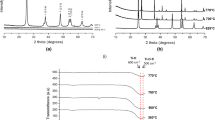Abstract
The Ni-doped and N-doped TiO2 nanoparticles were investigated for their antibacterial activities on Staphylococcus aureus (S. aureus) and Escherichia coli (E. coli) bacteria. Their morphological features and characteristics such as particle size, surface area, and visible light absorbing capacity were compared and discussed. Scanning electron microscopy, X-ray diffraction, and UV–visible spectrophotometry were used to characterize both materials. The inactivation of E. coli (as an example of Gram-negative bacteria) and S. aureus (as an example of Gram-positive bacteria) with Ni-doped and N-doped TiO2 was investigated in the absence and presence of visible light. Antibacterial activity tests were conducted using undoped, Ni-doped, and N-doped TiO2. The N-doped TiO2 nanoparticles show higher antibacterial activity than Ni-doped TiO2. The band gap narrowing of N-doped TiO2 can induce more visible light absorption and leads to the superb antibacterial properties of this material. The complete inactivation time for E. coli at an initial cell concentration of 2.7 × 104 CFU/mL was 420 min which is longer than the 360 min required for S. aureus inactivation. The rate of inactivation of S. aureus using the doped TiO2 nanoparticles in the presence of visible light is greater than that of E. coli. The median lethal dose (LD50) values of S. aureus and E. coli by antibacterial activity under an 18-W visible light intensity were 80 and 350 mg/ml for N-doped TiO2, respectively.









Similar content being viewed by others
References
Adams LK, Lyon DY, Alvarez PJJ (2006) Comparative eco-toxicity of nanoscale TiO2, SiO2, and ZnO water suspensions. Water Res 40:3527–3532
Ananpattarachai J, Kajitvichyanukul P, Seraphin S (2009) Visible light absorption ability and photocatalytic oxidation activity of various interstitial N-doped TiO2 prepared from different nitrogen dopants. J Hazard Mater 168:253–261
Asahi R, Morikawa T, Ohwaki T, Aoki K, Taga Y (2001) Visible-light photocatalysis in nitrogen-doped titanium oxides. Science 293:269–271
Blake DM, Maness PC, Huang Z, Wolfrum EJ, Huang J, Jacoby WA (1999) Application of the photocatalytic chemistry of titanium dioxide to disinfection and the killing of cancer cells. Sep Purif Methods 28:1–50
Caballero L, Whitehead KA, Allen NS, Verran J (2009) Inactivation of Escherichia coli on immobilized TiO2 using fluorescent light. J Photochem Photobiol A 202:92–98
Choi J, Park H, Hoffmann MR (2010) Effects of single metal-ion doping on the visible light photoreactivity of TiO2. J Phys Chem C 114:783–792
Cushnie T, Robertson P, Officer S, Pollard P, McCullagh C, Robertson J (2009) Variables to be considered when assessing the photocatalytic destruction of bacterial pathogens. Chemosphere 74:1374–1378
Delekar SD, Yadav HM, Achary SN, Meena SS, Pawar SH (2012) Structural refinement and photocatalytic activity of Fe-doped anatase TiO2 nanoparticles. Appl Surf Sci 263:536–545
Egerton TA, Kosa SAM, Christensen PA (2006) Photoelectrocatalytic disinfection of E. coli suspensions by iron doped TiO2. Phys Chem Chem Phys 8:398–406
Foster HA, Ditta IB, Varghese S, Steele A (2011) Photocatalytic disinfection using titanium dioxide: spectrum and mechanism of antimicrobial activity. Appl Microbiol Biotechnol 90:1847–1868
Fu G, Vary PS, Lin CT (2005) Anatase TiO2 nanocomposites for antimicrobial coatings. J Phys Chem B 109:8889–8898
Fujishima A, Zhang X (2006) Titanium dioxide photocatalysis: present situation and future approaches. C R Chim 9:750–760
Karunakaran C, Abiramasundari G, Gomathisankar P, Manikandan G, Anandi V (2010) Cu-doped TiO2 nanoparticles for photocatalytic disinfection of bacteria under visible light. J Colloid Interface Sci 352:68–74
Reddy KM, Manorama SV, Reddy AR (2002) Bandgap studies on anatase titanium dioxide nanoparticles. Mater Chem Phys 78:239–245
Sunada K, Watanabe T, Hashimoto K (2003) Studies on photokilling of bacteria on TiO2 thin film. J Photochem Photobiol A 156:227–233
Ubonchonlakate K, Sikong L, Tontai T, Saito F (2010) P. aeruginosa inactivation with silver and nickel doped TiO2 film coat on glass fiber riving. Adv Mater Res 150–151:1726–1731
Umebayashi T, Yamaki T, Yamamoto S, Miyashita A, Tanaka S, Sumita T, Asai K (2003) Sulfur-doping of rutile-titanium dioxide by ion implantation: photocurrent spectroscopy and first-principles band calculation studies. J Appl Phys 93:5156–5160
Wang X, Gong W (2008) Bactericidal and photocatalytic activity of Fe3+-TiO2 thin films prepared by the sol-gel method. J Wuhan Univ Technol-Mater Sci Ed 23:155–158
Xu TH, Song CL, Liu Y, Han GR (2006) Band structures of TiO2 doped with N, C and B. J Zhejiang Univ Sci B 7:299–303
Yadav HM, Otari SV, Koli VB, Mali SS, Hong CK, Pawar SH, Delekar SD (2014) Preparation and characterization of copper-doped anatase TiO2 nanoparticles with visible light photocatalytic antibacterial activity. J Photochem Photobiol A 280:32–38
Acknowledgments
Financial support from Center of Excellence on Environmental Research and Innovation, Faculty of Engineering, Naresuan University is gratefully acknowledged.
Author information
Authors and Affiliations
Corresponding author
Additional information
Responsible editor: Angeles Blanco
Rights and permissions
About this article
Cite this article
Ananpattarachai, J., Boonto, Y. & Kajitvichyanukul, P. Visible light photocatalytic antibacterial activity of Ni-doped and N-doped TiO2 on Staphylococcus aureus and Escherichia coli bacteria. Environ Sci Pollut Res 23, 4111–4119 (2016). https://doi.org/10.1007/s11356-015-4775-1
Received:
Accepted:
Published:
Issue Date:
DOI: https://doi.org/10.1007/s11356-015-4775-1




